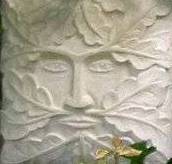Scribble City Central's seventeenth Fantabulous Friday comes from award-winning children's author Linda Newbery. It's particularly appropriate that her piece appears at the time of Midsummer - that moment when fairies dance in the green meadows and the veil between earth and otherworld is thin.
 |
| Detail from cover of 'Lob' by Linda Newbery (David Fickling Books) |
When I read Linda's book, Lob, it took me back to my own childhood, where my grandmother was most definitely one who 'Saw', rather like the-Lucy-of-the-book's Grandpa Will. She read me books like Puck of Pook's Hill (written by Kipling in her own nursery) and Juliana Ewing's Lob-lie-by-the-Fire - to her (and to me), the small folk of wood and field were as real as rainbows. She left with me a great love of digging my fingers into good soil, and growing my own vegetables. I hope that Linda's wonderful book will spark the same love in many of the children who read it - she's certainly eminently qualified to unravel the mystery that is
G for Green Man
The Unseen Mystery
The Green Man is full of contradictions. He is masculine, but embodies female qualities of fertility and regeneration. He is pagan, predating Christianity by at least three millennia, but is to be found in many a church and cathedral, carved in stone and peering out of arches, choir-screens or roof-bosses. He may seem part of English rural tradition, but is also found in Asia and West Africa. He is timeless, but speaks particularly to our time. It’s not far-fetched to say that the Green Man has come to be an embodiment of the Gaia hypothesis propounded by James Lovelock: that the Earth can be regarded as a complex organism which regulates itself, maintaining the conditions necessary for life to flourish. (Is Gaia theory mystical nonsense? How does it fit in with natural selection? I’m sure there’s many an internet forum devoted to the debate.)
The Green Man walked into my life during a period when I was teaching the poetry of Edward Thomas for A-Level. On my drive to school along a rural A-road, I occasionally passed an old man walking – a tramp, I presumed from his appearance, though I may have been wrong about that. I began to look out for him, and to associate him with Edward Thomas’ poem Lob:
“At hawthorn-time in Wiltshire travelling
In search of something chance would never bring,
An old man’s face, by life and weather cut
And coloured – rough, brown, sweet as any nut –
A land face, sea-blue-eyed – hung in my mind
When I had left him many a mile behind.”
When the poet goes back to ask local people who the man was, he’s given a range of names and identities, and the intriguing idea that:
“Although he was seen dying at Waterloo,
Hastings, Agincourt, and Sedgmoor too, -
Lives yet.”
This old man, in his many guises, is part of the English countryside, naming its wild flowers, its copses and lanes.
My story Lob grew from there. Lob, like Edward Thomas’ old man, is a conflation of the Green Man with another figure from folklore, the friendly house-hob or Lob-lie-by-the-Fire, who does odd jobs around the place and sleeps by the fire’s embers. My Lob is a gardening specialist, helping Lucy’s Grandpa Will with weeding and planting and keeping the tools clean.
“Lob was older than anyone could know. Not as old as the hills, but much older than the trees. Not as old as life, but much older than anyone living. Not as old as death, but far, far older than anyone born.”
Lob stays with his special person, the rare person who can see him, but when that person dies (and Grandpa does die, suddenly and shockingly, in this book – I felt that the story demanded a death) he takes to the road, going wherever his feet lead him.
The typical representation of a Green Man is as a foliate head – a face made all or partly of leaves: a plant that is half man, or a man that is half tree, as if his veins contain not blood but sap. Green man faces can be benign, mischievous, angry, anguished, quizzical. Often, leaves or stems grow from the mouth, the nose and even the eyes, and some of those faces have a tortured appearance, as if the lushness of new growth is wrested out of him at some cost.
The Green Man represents death and life, decay and regrowth, the cycle of the seasons. In the twenty-first century, with our awareness of the fragility of the planet still only recent, and our concerns for population explosions and the effects of climate change becoming more and more urgent, the Green Man is a reminder that nature is more important than we are. We’re part of the natural world, not its proprietors. The Green Man tolerates us, but isn’t bothered whether we’re around or not. He’ll be here, whatever happens to us.
SCC: Thank you, Linda, that was really evocative, and I absolutely agree with that last sentiment about the fragility of our planet. If the Green Man deserts us, we are all lost.
Next week: The inscrutable cait sith that is G for Grimalkin, with SCC's first guest from the USA, Julie Kagawa, author of the Iron Fey YA fantasy series. See you then!




















1 comment:
Loved this. And Gaia, mystical nonsense? No! I'm reading Dawkins' 'Selfish Gene', where he explains exactly how unconscious, unthinking bits of 'life' can and do, without forward thinking or planning of any kind, build enormously complex bodies - which is exactly what Lovelock argues the Earth has done.
Post a Comment